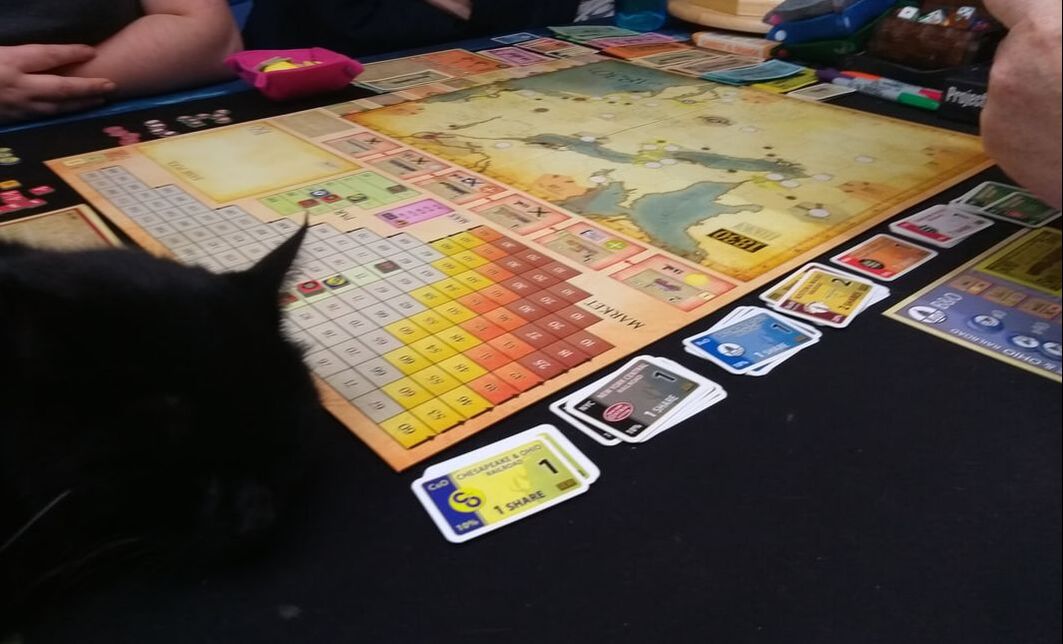|
26th October 2019 Saturday evening has rolled round again and we're at Matakishi's for some gaming goodness. Tonight we played '1830', or to give it its full name; '1830: The Game of Railroads and Robber Barons'. As you will have surmised, this is a game about railroad building. Actually, it's probably fair to say it's the game about railroad building. What's in a game? 1830's components are very 'old-school' and clearly favour function over form.
How's it play? Setup 1830 was originally published in 1986. The version we played was published in 2011 by Mayfair Games. There was some head-scratching during set up as it turns out in this edition there are several variants of the game. We had been trying to set up the 'basic' version of the game, which apparently is different to the 'classic' version (Which is what we wanted to play.). The basic version of the game should be the classic version, do you hear Mayfair Games! Anyway, on with setup.
Bidding Bidding only occurs once in the game (Right at the start.). Players have to bid for the right to buy one of the private companies. Auctioning is actually very straightforward. One player makes a starting bid (Whoever is nominated as 'The Banker' should start.), then proceeding clockwise, each player has to make a higher bid or pass. If a player passes, then they are out of the auction permanently. When everybody has passed, then the player who was the highest bidder, gets the 'privilege' of choosing which private company to buy first (Yes, even though you may have bid loads of money, you still have to pay to buy a private company!), also the highest bidder gets to take the 'Priority' card for the first stock market round. Second highest bidder gets second choice of buying a private company and so on until all the players have a private company. Stock market and operating rounds This is where the majority of the game takes place. At the beginning of the game there will be a stock market round followed by an operating round. Later on, there will be a stock market round followed by two operating rounds. Even further into the game, the stock market round will be followed by three operating rounds. Stock market round
When a company is floated, the following occurs:
So now we're on to the operating round(s). The following occurs:
Endgame Play continues until all the money from the bank has been paid out to the players. Winning is determined by who has acquired the most personal wealth. Players add up all the personal money they have accumulated and the combined stock market value of all the shares they own. The operating capital of any companies that the player may control is not added to the final tally. Highest score wins. Overall
It's a testament to 1830's design that 30 years on, it's mechanics and rules are still totally solid and watertight. The stock market round is well balanced so it has enough depth to be engaging and interesting, but is not head scratching in complexity. I really like it that player's money is entirely separated from the money needed to run a company. I also like how in order to maximise your personal profitability, you'll also need to invest in companies run by other players. Because no player can own more than 60% in a company, this will happen. The operating rounds give players plenty of choice and options when expanding their companies. Eventually there will be sets of intricate and convoluted rail networks interacting and criss-crossing with each other. Players also need to pay close attention to the money that their companies maintain as having a company go bankrupt will have serious consequences for the stock value. On the box of 1830, it says that it takes 3-6 hours to play and that's no exaggeration. It is the only drawback to 1830 is that I can think of. 1830 is a classic and there's no doubt about it. There are plenty of other rail building games and many of them are good. But if you've got the hours to spare, none are as good as 1830. It only remains for me to say that it seems that the game was last in print a few years ago. It's criminal that it's still out of print now, considering just how good a game 1830 is.
0 Comments
Leave a Reply. |
AuthorI play, I paint. Archives
March 2024
Categories
All
|



 RSS Feed
RSS Feed
